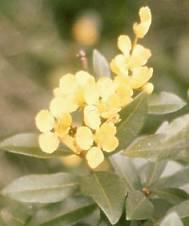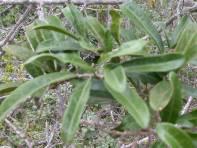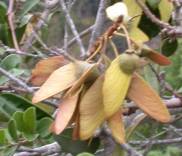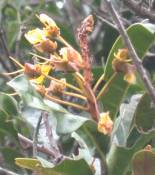Acridocarpus natalitus
Acridocarpus natalitius A.Juss. var. natalitius
Family: Malpighiaceae
Common names: moth-fruit, the binder (Eng.); motvrug (Afr.); umabophe, umabophawentaba, umabopha and ihlalanyosi (isiZulu)
SA Tree No: 303.6
Introduction
Its beautiful flowers and fruit make this evergreen shrub or small tree an appealing garden subject which should be in most gardens in the warmer and coastal parts of South Africa.

Description
Description
Umabophe can be a small tree, a scrambling shrub, a twiner or a rambling shrub on other vegetation. The tree is 1 to 5 m high, young stems and leaves are sometimes covered with velvety reddish pink hairs that fall off later. Leaves are alternate, simple, shiny dark green and leathery, with prominent midrib and net veins on the undersurface, 30-200 x 10-60 mm.

The bark is grey and rough, and the tips of the branches twine around other vegetation. The bright yellow or golden yellow flowers appear in September to February, in long triangular-shaped sprays that are often found at the ends of branches. The fruit has three but often two large, prominently veined wings that are joined together, which makes it look like a moth with outstretched wings and are normally seen from November to April.

Conservation Status
Status
Acridocarpus natalitius is not protected or threatened in any way.
Distribution and habitat
Distribution description
Moth-fruit is a common member of coastal forest, forest margins, bushveld and sand forest. It is sometimes found on rocky outcrops or open grassland. It occurs in the northern Eastern Cape in the Pondoland region, along the KwaZulu-Natal eastern seaboard to Maputaland, Swaziland, Mpumalanga's lowveld, Limpompo and Mozambique.
Derivation of name and historical aspects
History
The genus name is derived from Greek words, akris which means locust, and karpos meaning fruit, alluding to the winged fruit. In isiZulu, bopha means arrest or tie. The genus Acridocarpus consists of about 30 species, all from tropical and subtropical Africa; with only one species in southern Africa.
Ecology
Ecology
This plant is usually a hive of activity as fully opened flowers are frequently visited by ants and bumble bees; it also provides shelter to Skipper butterflies which breed on it. The leaves are prized by other creatures such as game, which nibble them.
Uses
Use
Roots can be mixed with other ingredients to make a mixture (intelezi ) which is used to hinder court procedure. When used in this manner the plaintiff will either become mute, irrelevant or highly repetitive. This results in the case being postponed indefinitely or brought to a speedy end. Herdboys place a piece of the root of umabophe under the tongue to avoid punishment at home after the cattle have strayed into crops. Spermacoce natalensis, which is in the family Rubiaceae is also called umabophe and its roots are used in the same way by herdboys. Roots are also used as intelezi for sprinkling around the homestead during a thunderstorm, to strengthen fighting sticks before traditional competition, to cleanse the whole family (through induced vomiting) after lightning has struck the homestead. This is a prized ornamental plant among gardeners.

Growing Acridocarpus natalitus
Grow
It must be planted in a part of the garden where it will get morning sun. For best display plant them in groups of three or four.
It can be planted from seed or cuttings in deep sandy soil with a lot of old kraal (cattle pen) manure and compost. Planting should be done in late spring or early summer then watered on a regular basis.
Moth-fruit does not seem to have any pests.
References
- Leistner, O.A. 2000. Seed plants of southern Africa : families and genera. Strelitzia 10. National Botanical Institute, Pretoria.
- Ngwenya, M.A., Koopman, A. & Williams, R. 2003. Ulwazi LwamaZulu Ngezimila: isingeniso; Zulu Botanical Knowledge: an introduction. National Botanical Institute, Durban.
- Palmer, E. & Pitman, N. 1972. Trees of southern Africa. Balkema, Cape Town.
- Pienaar, K. 1985. Grow South African plants. Struik, Cape Town.
- Pooley, E. The complete field guide to trees of Natal, Zululand and Transkei. Natal Flora Publications Trust, Durban.
Credits
Mkhipheni Ngwenya
KwaZulu-Natal Herbarium
June 2005
Plant Attributes:
Plant Type: Shrub, Tree
SA Distribution: Eastern Cape, KwaZulu-Natal, Limpopo, Mpumalanga
Soil type: Loam
Flowering season: Late Summer
PH: Acid, Neutral
Flower colour: Yellow
Aspect: Morning Sun (Semi Shade), Afternoon Sun (Semi Shade)
Gardening skill: Average
Special Features:
Horticultural zones









Rate this article
Article well written and informative
Rate this plant
Is this an interesting plant?
User Comments
Jabulani Mdakane, South Africa
September 01, 2017 at 8:34 AMGood day
Which nursery is selling this plant in Durban?
Kind regards.
Login to add your Comment
Back to topNot registered yet? Click here to register.